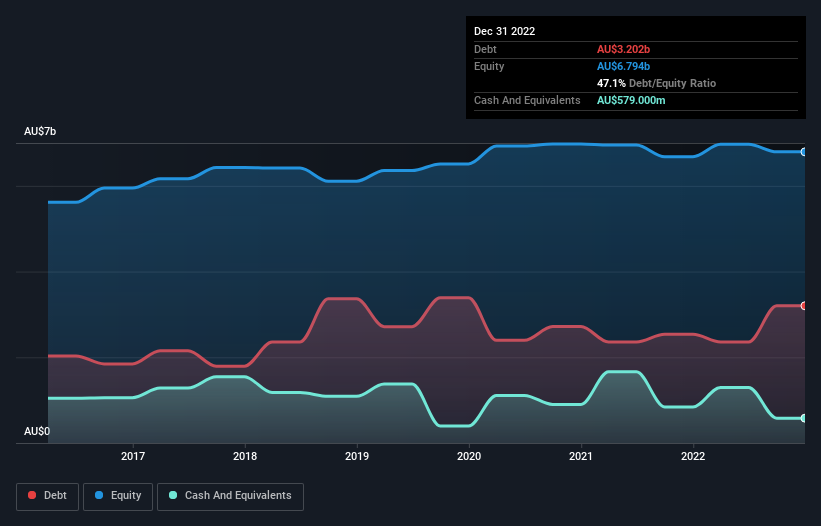David Iben put it well when he said, 'Volatility is not a risk we care about. What we care about is avoiding the permanent loss of capital.' When we think about how risky a company is, we always like to look at its use of debt, since debt overload can lead to ruin. Importantly, Lendlease Group (ASX:LLC) does carry debt. But the more important question is: how much risk is that debt creating?
What Risk Does Debt Bring?
Debt is a tool to help businesses grow, but if a business is incapable of paying off its lenders, then it exists at their mercy. In the worst case scenario, a company can go bankrupt if it cannot pay its creditors. While that is not too common, we often do see indebted companies permanently diluting shareholders because lenders force them to raise capital at a distressed price. Of course, the upside of debt is that it often represents cheap capital, especially when it replaces dilution in a company with the ability to reinvest at high rates of return. The first step when considering a company's debt levels is to consider its cash and debt together.
View our latest analysis for Lendlease Group
What Is Lendlease Group's Debt?
You can click the graphic below for the historical numbers, but it shows that as of December 2022 Lendlease Group had AU$3.20b of debt, an increase on AU$2.54b, over one year. However, it does have AU$579.0m in cash offsetting this, leading to net debt of about AU$2.62b.

A Look At Lendlease Group's Liabilities
Zooming in on the latest balance sheet data, we can see that Lendlease Group had liabilities of AU$4.97b due within 12 months and liabilities of AU$5.66b due beyond that. Offsetting this, it had AU$579.0m in cash and AU$1.69b in receivables that were due within 12 months. So its liabilities outweigh the sum of its cash and (near-term) receivables by AU$8.36b.
This deficit casts a shadow over the AU$4.78b company, like a colossus towering over mere mortals. So we definitely think shareholders need to watch this one closely. At the end of the day, Lendlease Group would probably need a major re-capitalization if its creditors were to demand repayment.
In order to size up a company's debt relative to its earnings, we calculate its net debt divided by its earnings before interest, tax, depreciation, and amortization (EBITDA) and its earnings before interest and tax (EBIT) divided by its interest expense (its interest cover). Thus we consider debt relative to earnings both with and without depreciation and amortization expenses.
Lendlease Group shareholders face the double whammy of a high net debt to EBITDA ratio (24.1), and fairly weak interest coverage, since EBIT is just 0.032 times the interest expense. The debt burden here is substantial. However, the silver lining was that Lendlease Group achieved a positive EBIT of AU$3.0m in the last twelve months, an improvement on the prior year's loss. The balance sheet is clearly the area to focus on when you are analysing debt. But ultimately the future profitability of the business will decide if Lendlease Group can strengthen its balance sheet over time. So if you want to see what the professionals think, you might find this free report on analyst profit forecasts to be interesting.
Finally, a company can only pay off debt with cold hard cash, not accounting profits. So it's worth checking how much of the earnings before interest and tax (EBIT) is backed by free cash flow. Over the last year, Lendlease Group saw substantial negative free cash flow, in total. While investors are no doubt expecting a reversal of that situation in due course, it clearly does mean its use of debt is more risky.
Our View
On the face of it, Lendlease Group's conversion of EBIT to free cash flow left us tentative about the stock, and its level of total liabilities was no more enticing than the one empty restaurant on the busiest night of the year. But at least its EBIT growth rate is not so bad. Considering all the factors previously mentioned, we think that Lendlease Group really is carrying too much debt. To us, that makes the stock rather risky, like walking through a dog park with your eyes closed. But some investors may feel differently. When analysing debt levels, the balance sheet is the obvious place to start. But ultimately, every company can contain risks that exist outside of the balance sheet. Be aware that Lendlease Group is showing 1 warning sign in our investment analysis , you should know about...
At the end of the day, it's often better to focus on companies that are free from net debt. You can access our special list of such companies (all with a track record of profit growth). It's free.
New: AI Stock Screener & Alerts
Our new AI Stock Screener scans the market every day to uncover opportunities.
• Dividend Powerhouses (3%+ Yield)
• Undervalued Small Caps with Insider Buying
• High growth Tech and AI Companies
Or build your own from over 50 metrics.
Have feedback on this article? Concerned about the content? Get in touch with us directly. Alternatively, email editorial-team (at) simplywallst.com.
This article by Simply Wall St is general in nature. We provide commentary based on historical data and analyst forecasts only using an unbiased methodology and our articles are not intended to be financial advice. It does not constitute a recommendation to buy or sell any stock, and does not take account of your objectives, or your financial situation. We aim to bring you long-term focused analysis driven by fundamental data. Note that our analysis may not factor in the latest price-sensitive company announcements or qualitative material. Simply Wall St has no position in any stocks mentioned.
About ASX:LLC
Lendlease Group
Operates as an integrated real estate and investment company in Australia, Asia, Europe, and the Americas.
Undervalued with moderate growth potential.
Similar Companies
Market Insights
Community Narratives




